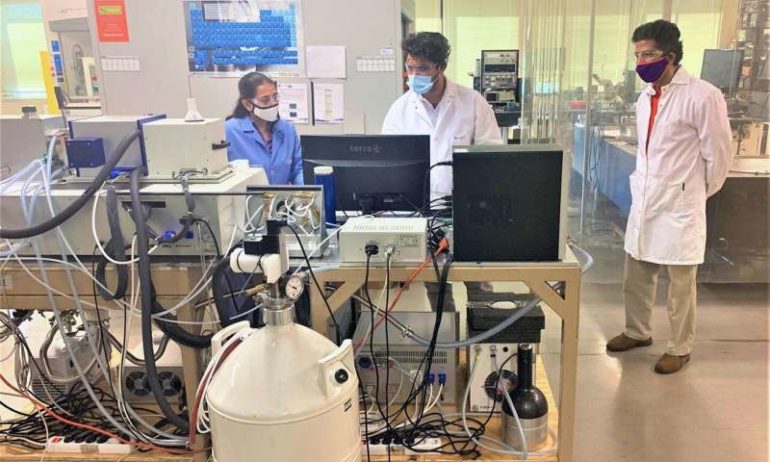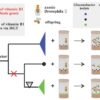Groundbreaking science is often the result of true collaboration, with researchers in a variety of fields, viewpoints and experiences coming together in a unique way. One such effort by Clemson University researchers has led to a discovery that could change the way the science of thermoelectrics moves forward.
Graduate research assistant Prakash Parajuli; research assistant professor Sriparna Bhattacharya; and Clemson Nanomaterials Institute (CNI) Founding Director Apparao Rao (all members of CNI in the College of Science’s Department of Physics and Astronomy) worked with an international team of scientists to examine a highly efficient thermoelectric material in a new way—by using light.
Their research has been published in the journal Advanced Science and is titled “High zT and its origin in Sb-doped GeTe single crystals.”
“Thermoelectric materials convert heat energy into useful electric energy; therefore, there is a lot of interest in materials that can convert it most efficiently,” Parajuli said
Bhattacharya explained that the key to measuring progress in the field is the figure of merit, noted as zT, which is highly dependent on the property of thermoelectric materials. “Many thermoelectric materials exhibit a zT of 1-1.5, which also depends on the temperature of the thermoelectric material. Only recently have materials with a zT of 2 or higher have been reported.”
“This begs the question, how many more such materials can we find, and what is the fundamental science that is new here through which a zT greater than 2 can be achieved?” Rao added. “Basic research is the seed from which applied research grows, and to stay at the forefront in thermoelectrics we teamed up with professor Yang Yuan Chen’s team at the Academia Sinica, Taiwan.”
Chen and Rao’s teams focused on Germanium Telluride (GeTe), a single crystal material.
“GeTe is of interest, but plain GeTe without any doping does not show exciting properties,” Bhattacharya said. “But once we add a little bit of antimony to it, it does show good electronic properties, as well as very low thermal conductivity.”
While others have reported GeTe-based materials with high zT, these were polycrystalline materials. Polycrystals have boundaries among the many small crystals of which they are formed. While such boundaries favorably impede heat transfer, they mask the origin of fundamental processes that lead to high zT.
“Here, we had pure and doped GeTe single crystals whose thermoelectric properties have not been reported,” Bhattacharya said. “Therefore, we were able to evaluate the intrinsic properties of these materials that would otherwise be difficult to decipher in the presence of competing processes. This may be the first GeTe crystal with antimony doping that showed these unique properties—mainly the ultra-low thermal conductivity.”
This low thermal conductivity came as a surprise, since the material’s simple crystalline structure should allow for heat to flow easily throughout the crystal.
“Electrons carry the heat and electricity, so if you block the electrons, you have no electricity,” Parajuli said. “Hence, the key is to block the flow of heat by the quantized lattice vibrations known as phonons, while allowing electrons to flow.”
Doping GeTe with the right amount of antimony can maximize electron flow and minimize heat flow. This study found that the presence of 8 antimony atoms for every 100 GeTe gives rise to a new set of phonons, which effectively reduce heat flow that was confirmed both experimentally and theoretically.
The team, along with collaborators who grew the crystals, performed electronic and thermal transport measurements in addition to density functional theory calculations to find this mechanism in two ways: first, through modeling, using the thermal conductivity data; second, through Raman spectroscopy, which probes the phonons within a material.
“This is a totally new angle for thermoelectric research,” Rao said. “We are sort of pioneers in that way—decoding thermal conductivity in thermoelectrics with light. What we found using light agreed well with what was found through thermal transport measurements. Future research in thermoelectrics should use light—it’s a very powerful nondestructive method to elucidate heat transport in thermoelectrics. You shine light on the sample, and collect information. You aren’t destroying the sample.”
Rao said that the collaborators’ wide range of expertise was key to their success. The group included Fengjiao Liu, a former Ph.D. student at CNI; Rahul Rao, Research Physical Scientist at the Air Force Research Laboratory, Wright-Patterson Air Force Base; and Oliver Rancu, a high school student at the South Carolina Governor’s School for Science and Mathematics who worked with the team through Clemson’s SPRI (Summer Program for Research Interns) program. Because of the pandemic, the team worked with Rancu via Zoom, guiding him with some of Parajuli’s calculations using an alternate Matlab code.
“I am so very grateful for the opportunity to work with the CNI team members this summer,” said Rancu, who hails from Anderson, South Carolina. “I have learned so many things about both physics and the research experience in general. It truly was priceless, and this research publication is just another addition to an already fantastic experience.”
“I was very impressed by Oliver,” Parajuli added. “He caught on quickly with the necessary framework for the theory.”
Sprinkled with power: How impurities enhance a thermoelectric material at the atomic level
More information:
Ranganayakulu K. Vankayala et al, High zT and Its Origin in Sb‐doped GeTe Single Crystals, Advanced Science (2020). DOI: 10.1002/advs.202002494
Provided by
Clemson University
Citation:
Researchers decode thermal conductivity with light (2020, November 9)
retrieved 9 November 2020
from https://phys.org/news/2020-11-decode-thermal.html
This document is subject to copyright. Apart from any fair dealing for the purpose of private study or research, no
part may be reproduced without the written permission. The content is provided for information purposes only.



